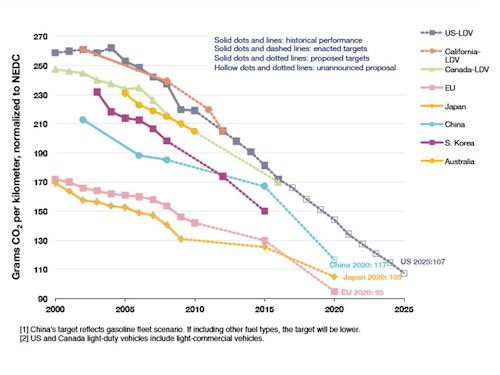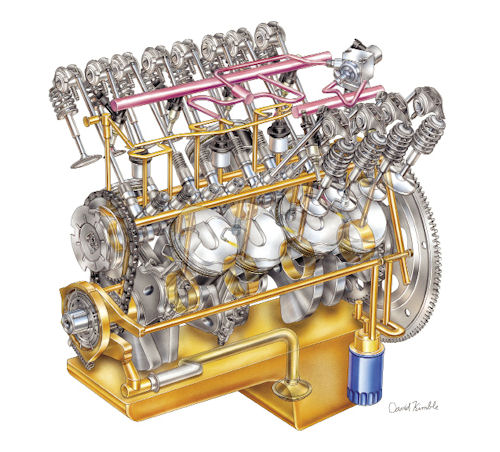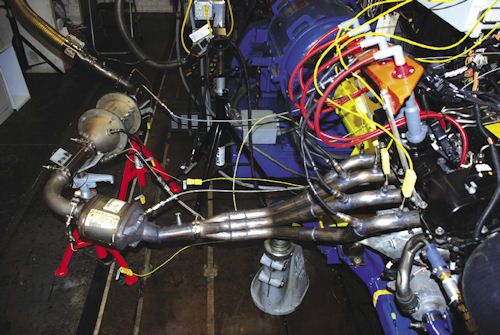Latest News
January 1, 2014
By Randy Frank
Massive information transmission, storage and processing, often called big data, starts with more sensor data in control systems. With sensors providing the input, National Instruments (NI) uses the term “Big Analog Data” to describe the changes occurring to control systems.
“We say that it is analog, because the data that we are collecting comes from the physical world and it’s going to be all types of different signals,” says Stephanie Orci, a product manager and member of NI’s Big Analog Data team. Big Analog Data does not, however, mean the data stays in analog form.
“One of the key differentiators between our big data and others is that it has to be digitized in some way,” says Orci. “We have to take it and convert it from that analog signal—usually to some digital format that we can read off a computer.”
In automobiles, powertrain control is an excellent example of Big Analog Data. Increasing complexity in vehicle engine management systems is more than a clich ©. Today’s automotive engineers at vehicle original equipment manufacturers (OEMs) and Tier I suppliers have to approach the data collection and validation process differently than they have in the recent past, to deal with the added complexity, tougher regulations and increased customer expectations while continuing to meet deadlines.
 Fig. 1: Historical and current or proposed standards fleet CO2 emissions performance shows continuous improvement, and indicates the level of increasing complexity required to make these improvements. Image courtesy of the International Council of Clean Transportation. |
Engine management systems have used several sensor inputs and increasingly powerful microcontrollers (MCUs) and digital signal processors (DSPs) to control solenoids, motors, heaters and other actuators to obtain lower emissions and higher fuel economy. With today’s regulations—and those that are expected to be required within the next few years—cranking down the emission and fuel consumption increases the challenges to system designers.
No End to Global Regulations
In the U.S., the Corporate Average Fuel Economy (CAFE) requirement for 2016 average fuel efficiency is 35.5 mpg, or roughly 250 grams of carbon dioxide (CO2) per mile. This level increases to 54.5 mpg by 2025. Other regions of the world specify higher efficiency requirements in terms of grams of CO2/kilometer. From 2000 to 2025, the U.S. reduction of CO2 emissions is dramatic, but not as low as other regions (see Fig. 1).
Traditional improvements to reduce CO2 by reducing weight, rolling resistance and improving aerodynamic properties can only go so far, however. Electronics in powertrain control provides added capability, to achieve aggressive improvements and reduce the grams of CO2/mile.
Carmakers Respond
In North America, General Motors has a number of centers that specialize in simulation, modeling and verification technology for powertrain applications, including those in Pontiac, Milford and Warren, MI.
“One specific area we anticipate continuing to grow is simulation, and our efforts to move from Road to Lab to Math (RLM),” says Radu Theyyunni, engineering group manager for powertrain system design and computational fluid dynamics (CFD) analysis at General Motors. “We see our high-speed computing environment increasing in capability and capacity, and terabyte data management is something we will need to deal with on an ongoing basis.”
 Fig. 2: In GM’s 5.3L engine, cylinder deactivation works seamlessly through controlled oil pressure to shut off four of eight cylinders in light load conditions to save customers fuel. This lubrication system operates in conjunction with direct injection and continuously variable valve timing, which are all monitored by an advanced and reliable powertrain control system. Image courtesy of General Motors. |
GM is handling the increased complexity of data management in a few fundamental ways.
“One key initiative is that more ‘technology’ and up-integration is occurring to accommodate additional I/O in parallel with reducing packaging space,” says Larry Hallman, director of powertrain global controls and software. “GM Powertrain Controls is developing a totally new generation of development tools—build, change, configuration management and variation control—to deal with the increasing complexity of the electronics, controls and software space.”
The all-new 5.3L Small Block V-8 lubrication system and fuel system shown in Fig. 2, for example, is used in the Chevrolet Silverado and GMC Sierra pickup trucks. These highly developed systems could not have been created without the state-of-the-art development tools.
Suppliers Respond
New system hardware and/or combinations of hardware require more computing performance, and add significant complexity to powertrain control. Here are just a few of the techniques that are being pursued to reduce emissions and improve fuel economy to meet global regulations:
- internal combustion plus electric power;
- direct injection;
- advanced knock detection, which could include the use of a pressure sensor in each cylinder;
- cylinder deactivation;
- stop/start;
- cylinder-by-cylinder control;
- electrohydraulic instead of mechanical variable valve timing (VVT);
- higher number of gears in automatic transmissions with current-controlled solenoids; and
- dual-clutch transmissions.
“They are all being used to reduce fuel consumption and improve emissions,” he says. “Complexity and cost determine to what extent any feature is implemented.”
To cope with any added system requirements, the amount of embedded memory in powertrain processors is continuously increasing.
“It’s 8MB flash now, but growing to 16 to 24 in the next decade,” Soja predicts, noting that the same situation occurs for the performance of powertrain processors: “It’s 300 MHz now, growing to 500 to 1,000 MHz in next decade.”
Freescale Semiconductor’s recently released Qorivva MPC5777M Power Architecture Microprocessor Control Unit (MCU) is a quad-core device targeting high-end powertrain applications that meets next-generation advanced engine control, functional safety and security requirements. It has 8MB of flash, operates at 300 MHz, and can connect to several vehicle networks. With this capability available today, system designers are embracing advanced tools for development.
“More and more model-based tools are required to model the physics of internal combustion and produce auto-generated code,” explains Soja.
Toolmakers Respond
NI tools are used in powertrain research, and its engineers frequently work closely with researchers. A recent project with Oak Ridge National Laboratory (ORNL) exemplifies how these tools are used.
ORNL researchers wanted to experiment with various lean burn catalysts to evaluate their impact on reducing CO2 emissions. Unlike a traditional gasoline engine control that uses a three-way catalyst, a lean burn strategy is much more complicated.
 Fig. 3: The Oak Ridge National Laboratory’s test engine and catalytic converter had numerous temperature measurements, in addition to those in the powertrain control. Image courtesy of National Instruments. |
To determine how the production controller operated, the research team monitored all of the signals going into and out of the controller. For any research effort that occurs outside of an OEM or its electronic control unit (ECU) supplier, this would be a common approach to getting around the lack of direct knowledge regarding the ECU’s code.
“If you are not the OEM, you have to do this every time,” explains Matt Viele, Ph.D., principal architect of the NI Powertrain Controls Group.
Over two weeks of chassis dynamometer time, the test setup collected a third of a terabyte of data (see Fig. 4).
“The most complicated was cylinder pressure, where we read the pressure, we know the engine position and we can calculate a lot of functions based on that,” Viele says.
 Fig. 4: Researchers built a data mining application in LabView to obtain the mean value of the collected data. Image courtesy of National Instruments. |
Next- and same-cycle cylinder-based control are both fast-response and data-intensive control techniques that are being evaluated.
“In next-cycle control, we are going to look at cylinder pressure, and we are going to do calculations,” Viele says, offering burn location or effective pressure as examples. “We will then have those ready for the next cylinder event.”
Lean burn operation increases the need for this type of control.
“If you’re running close to the lean stability limit, then you want to know that—to adjust your fuel timing for the next cycle,” says Viele.
Next-cycle control is something that NI has been able to do in research boards for years, but it is starting to be used in production controllers by some carmakers as well.
Same-cycle control using NI’s field-programmable gate array (FPGA) is able to provide very fast feedback from one injection pulse to the next, and adjust injection timing even sooner.
“There is not a whole lot of control authority because physical systems take some time,” explains Viele. “Our computations are sufficiently fast, so that we can monitor in-cylinder pressure, do some math and adjust the back end of injection pulses in the same cycle.”
Same-cycle control can avoid a misfire when the cylinder is running too lean, and save a test cycle before it is too late by taking the appropriate action immediately. With the FPGA in its compact reconfigurable I/O (CompactRIO), engineers can change the code in a few hours.
Viele admits the same type of thing could be accomplished in volume-production hardware with a dedicated digital signal processor (DSP) or in a multi-core processor with a dedicated core, but “it is a lot of work.”
Low-volume, high-cost vehicles such as off-road construction equipment can take (and have taken) the FPGA from lab into production. High-volume vehicles use a similar approach in R&D for researchers to make recommendations for production, but then employ tools appropriate for the type of hardware used in the production ECU. With the challenges that are ahead, more analog data will drive the need for even more comprehensive development tools.
Randy Frank is a contributor to DE. Send e-mail about this article to [email protected].
More Info
Subscribe to our FREE magazine, FREE email newsletters or both!
Latest News
About the Author
Randy FrankRandy Frank is a freelance technology writer based in Arizona. Contact him via [email protected].
Follow DE




